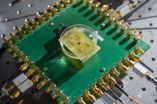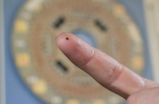(Press-News.org) Researchers have developed the technology for a catheter-based device that would provide forward-looking, real-time, three-dimensional imaging from inside the heart, coronary arteries and peripheral blood vessels. With its volumetric imaging, the new device could better guide surgeons working in the heart, and potentially allow more of patients' clogged arteries to be cleared without major surgery.
The device integrates ultrasound transducers with processing electronics on a single 1.4 millimeter silicon chip. On-chip processing of signals allows data from more than a hundred elements on the device to be transmitted using just 13 tiny cables, permitting it to easily travel through circuitous blood vessels. The forward-looking images produced by the device would provide significantly more information than existing cross-sectional ultrasound.
Researchers have developed and tested a prototype able to provide image data at 60 frames per second, and plan next to conduct animal studies that could lead to commercialization of the device.
"Our device will allow doctors to see the whole volume that is in front of them within a blood vessel," said F. Levent Degertekin, a professor in the George W. Woodruff School of Mechanical Engineering at the Georgia Institute of Technology. "This will give cardiologists the equivalent of a flashlight so they can see blockages ahead of them in occluded arteries. It has the potential for reducing the amount of surgery that must be done to clear these vessels."
Details of the research were published online in the February 2014 issue of the journal IEEE Transactions on Ultrasonics, Ferroelectrics and Frequency Control. Research leading to the device development was supported by the National Institute of Biomedical Imaging and Bioengineering (NIBIB), part of the National Institutes of Health.
"If you're a doctor, you want to see what is going on inside the arteries and inside the heart, but most of the devices being used for this today provide only cross-sectional images," Degertekin explained. "If you have an artery that is totally blocked, for example, you need a system that tells you what's in front of you. You need to see the front, back and sidewalls altogether. That kind of information is basically not available at this time."
The single chip device combines capacitive micromachined ultrasonic transducer (CMUT) arrays with front-end CMOS electronics technology to provide three-dimensional intravascular ultrasound (IVUS) and intracardiac echography (ICE) images. The dual-ring array includes 56 ultrasound transmit elements and 48 receive elements. When assembled, the donut-shaped array is just 1.5 millimeters in diameter, with a 430-micron center hole to accommodate a guide wire.
Power-saving circuitry in the array shuts down sensors when they are not needed, allowing the device to operate with just 20 milliwatts of power, reducing the amount of heat generated inside the body. The ultrasound transducers operate at a frequency of 20 megahertz (MHz).
Imaging devices operating within blood vessels can provide higher resolution images than devices used from outside the body because they can operate at higher frequencies. But operating inside blood vessels requires devices that are small and flexible enough to travel through the circulatory system. They must also be able to operate in blood.
Doing that requires a large number of elements to transmit and receive the ultrasound information. Transmitting data from these elements to external processing equipment could require many cable connections, potentially limiting the device's ability to be threaded inside the body.
Degertekin and his collaborators addressed that challenge by miniaturizing the elements and carrying out some of the processing on the probe itself, allowing them to obtain what they believe are clinically-useful images with only 13 cables.
"You want the most compact and flexible catheter possible," Degertekin explained. "We could not do that without integrating the electronics and the imaging array on the same chip."
Based on their prototype, the researchers expect to conduct animal trials to demonstrate the device's potential applications. They ultimately expect to license the technology to an established medical diagnostic firm to conduct the clinical trials necessary to obtain FDA approval.
For the future, Degertekin hopes to develop a version of the device that could guide interventions in the heart under magnetic resonance imaging (MRI). Other plans include further reducing the size of the device to place it on a 400-micron diameter guide wire.
INFORMATION:
In addition to Degertekin, the research team included Jennifer Hasler, a professor in the Georgia Tech School of Electrical and Computer Engineering; Mustafa Karaman, a professor at Istanbul Technical University; Coskun Tekes, a postdoctoral fellow in the Woodruff School of Mechanical Engineering; Gokce Gurun and Jaime Zahorian, recent graduates of Georgia Tech's School of Electrical and Computer Engineering, and Georgia Tech Ph.D. students Toby Xu and Sarp Satir.
This research was supported by award number R01EB010070 from the National Institute of Biomedical Imaging and Bioengineering (NIBIB), part of the National Institutes of Health (NIH). The content is solely the responsibility of the authors and does not necessarily represent the official views of the NIBIB or NIH.
CITATION: Gokce Gurun, et al., "Single-Chip CMUT-on-CMOS Front-end System for Real-Time Volumetric IVUS and ICE Imaging," (IEEE Transactions on Ultrasonics, Ferroelectrics and Frequency Control, 2014).
Single chip device to provide real-time 3-D images from inside the heart, blood vessels
2014-02-18
ELSE PRESS RELEASES FROM THIS DATE:
'Legal highs,' PMMA and zombie panic
2014-02-18
Recent deaths in both Canada and the UK linked to PMA/PMMA in ecstasy pills has brought public scrutiny to this little known drug. With Canadian producing most of the ecstasy in the North American market, this timely paper (Ecstasy, legal highs and designer drug use: A Canadian perspective) published this week in Drug Science Policy and Law looks at trends in ecstasy adulteration, the facts around PMA/PMMA-linked deaths and explores alternatives to the endless banning of new drugs.
It finds:
In 2007, according to the Health Canada Drug Analysis Service, only 3% of seized ...
A stretchable highway for light
2014-02-18
WASHINGTON, Feb. 18, 2014—For futuristic applications like wearable body sensors and robotic skin, researchers need to ferry information along flexible routes. Electronics that bend and stretch have become possible in recent years, but similar work in the field of optics – communicating with light instead of electrons – has lagged behind. Particularly difficult to engineer have been optics that stretch, lengthening when someone wearing body sensors bends to tie their shoe, or when a robotic arm twists through a full range of motion.
Now a team of Belgian researchers reports ...
Georgia Tech study reveals copyright complexities, social norms in online media creation
2014-02-18
In the age of mashups, fan fiction and content sharing, online media creation has spurred new complexities in copyright, effectively turning the legal concept of "fair use" on its ear, according to a new study from Georgia Tech.
Research into fan fiction and other types of remix communities reveals many legal misconceptions persistent among different groups when applying copyrighted work to their own creations. The research also highlights online social norms – independent of actual law – that guide the use of copyrighted works in fan communities.
For the study, Georgia ...
Clemson researchers develop sticky nanoparticles to fight heart disease
2014-02-18
CLEMSON, S.C. — Clemson University researchers have developed nanoparticles that can deliver drugs targeting damaged arteries, a non-invasive method to fight heart disease.
Heart disease is the leading cause of death in the U.S., according to the Centers for Disease Control and Prevention. One of the standard ways to treat clogged and damaged arteries currently is to implant vascular stents, which hold the vessels open and release such drugs as paclitaxel.
The researchers, led by Clemson bioengineering professor Naren Vyavahare, hope their advanced nanoparticles could ...
Transgender patients discriminated against for health care services
2014-02-18
VIDEO:
Discrimination against transgender people -- as many as one million Americans identify themselves as transgender -- should immediately be addressed by the medical establishment, backed by policy change at the...
Click here for more information.
DETROIT – Discrimination against transgender people –as many as one million Americans identify themselves as transgender – should immediately be addressed by the medical establishment, backed by policy change at the national ...
Frequent school moves can increase the risk of psychotic symptoms in early adolescence
2014-02-18
Researchers at Warwick Medical School have shown that frequently moving schools during childhood can increase the risk of psychotic symptoms in later years.
The study, published in the Journal of American Academy of Child and Adolescent Psychiatry, found that school mobility during childhood heightens the risk of developing psychotic-like symptoms in early adolescence by up to 60%.
Suffering from psychotic-like symptoms at young age is strongly associated with mental health problems in adulthood, including psychotic disorders and suicide.
Professor Swaran Singh, ...
Wisdom of app stores: Early identification of malicious Android apps from Google Play
2014-02-18
"How do I know that the new installed app behaves as described?" asks Andreas Zeller, professor of software engineering at Saarland University. So far experts have identified so-called malicious apps by checking their behavior against patterns of known attacks. "But what if the attack is brand-new?" asks Zeller.
His group seems to have found a new method to answer all these questions. Zeller summarizes the basic idea as follows: "Apps whose functionality is described in the app store should behave accordingly. If that is not the case, they are suspect."
His research ...
Do Guam mantas plan moon parties?
2014-02-18
Several of Hartup's paddler and free diving friends told her about seeing mantas congregating purposefully in an area where surgeonfish were spawning. Since they were able to give her an exact date, Julie was able to calculate the moon phase, which is important as many fish synchronize their spawning with the moon. Using this information she predicted when the spawning event would occur that upcoming year and was there to witness a shoal of spawning surgeonfish accompanied by a fever of mantas.
Hartup's research findings not only highlight important information about ...
Environmental issues examined through cohesive efforts
2014-02-18
CHICAGO – Solving crucial environmental issues such as global warming and water supply involves managing competing interests, uncertainty and risk, and this is best done through meaningful collaboration in a neutral environment.
Arizona State University Barrett Honors College Lecturer John N. Parker discussed the ways in which scientists, stakeholders and policy makers can communicate effectively by coming together through boundary organizations at the annual meeting of the American Association for the Advancement of Science in Chicago.
Boundary organizations are ...
NUS researchers make new discovery of protein as a promising target for treatment of ATC
2014-02-18
Anaplastic thyroid carcinoma (ATC) is an aggressive type of cancer with a poor prognosis for which there is currently no effective treatment. Researchers from the National University of Singapore (NUS) have discovered for the first time that an epithelial basement membrane protein, called laminin-5 gamma-2 (LAMC2), has the potential to be an ideal target for the treatment of ATC.
Led by Professor H. Phillip Koeffler, Senior Principal Investigator, and Dr Manoj Garg, Research Fellow, at the Cancer Science Institute of Singapore (CSI Singapore) at NUS, the team is also ...






